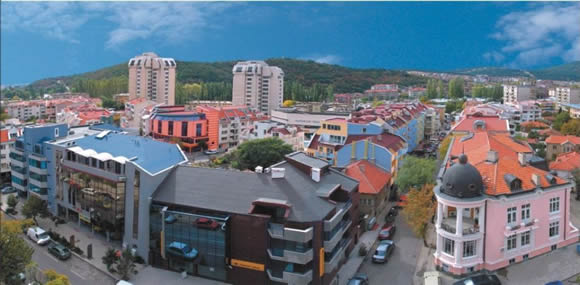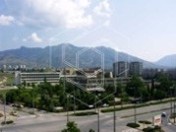| Sliven |
 |
Region
Sliven is the eighth largest city in Bulgaria. Throughout the centuries it has played an important role in the historical and economic area development as well as in the country. The location of the city is defined by the following coordinates: 260 19′E longitude and 420 42 ′N latitude. Its altitude is 270 m above sea level. The distance in km from Sliven to Sofia is 291 km on road network and 331 km on rail. Set high up is the Sliven Mountain, part of the Balkans with its peak Bulgarka, 1181 m, and the famous natural Blue Stones heritage site.
Welcome to the town of Sliven, where Dobry Zhelyaskov was the first to establish a Bulgarian textile factory in 1834, thus starting our industrial development.

You are given the chance to be acquainted with the second biggest industrial centre in southeast Bulgaria, which has always been considered important . Sliven is a city with long-lived textile traditions; it is also known for its machine-building industry, glass production, electro-technical and food industries. The region has been known as ‘The Valley of the Peaches’. Sliven will give you the chance to feel the spirit of history, traditions along with that the pulse of contemporary dynamics and diversity.
Being one of the most significant cultural centres in Bulgaria during the Renaissance, Sliven has preserved and enriched Bulgarian cultural heritage and today it offers a lot of cultural events to its citizens and visitors. A birthplace of prominent Bulgarian enlighteners, Sliven has also fostered a lot of writers, scientists and intelligent people, who have always respected and cared about education.
Nature wonders in Sliven are unquestionable. The unique Blue Stones rock array together with Karandila National Park, its fresh air and mineral springs offer diverse opportunities for leisure and tourism.
The town is located in the north Sliven flat fields. Its climate is typical for its geographic location, with some specific features. The annual temperature amplitude is 21.60. The total amount of rainfall is 596 mm. Characteristic feature of the city is the river valleys northwest, which contribute to the formation of the famous Bora wind, Sliven is well-known for. It blows mainly in wintertime when high-pressure areas in the north and low-pressure areas in the south of the Balkans are formed. The city has a healthy transitional continental climate. Situated at the foot of the mountains, Sliven is well supplied with water resources. The three rivers that pass through the city and merge together are the most likely reason for the name of the place, Sliven. Furthermore, the Balkans offer significant forest wealth to all its citizens. It is interesting to know that most of the forests are deciduous, tall almost everywhere.
Sliven today stemed from the Ottoman rule as its mediaval successor. In 1836 the first factory for the production of homespun was founded to satisfy the needs of the Ottoman army for clothing. Around 100,000 rook and homespun cloth (Hohsteter) were produced. Sliven has played a significant role in the struggle for the liberation of the Bulgarian people. There is hardly another city in Bulgaria that has given so many Renaissance enlighteners and rebels for freedom. In 18th and 19th century Sliven had about 100 chieftains, the most famous of whom are Hadji Dimitar, Khitov, Tanio, Zlati, Indjee, Kondyo, Christo, Radoi, Kara Sabi, etc. Sliven famous Renaissance figures are Dr. Ivan Seliminski, Dobri Chintulov, Mikhail Coloni, Dimitar Dobrovich, Dr. Mirkovich and others.
After the liberation and the wars (1912-1913 and 1914-1918) major changes in the industry of the city and especially in the textile industry took place. Business consolidated and production as a whole decreased by almost half. This led to the development and creation of other branches of the textile industry. Vine growing rapidly developed. Transport, construction and interconnections in the city started to improve.
Particularly good opportunities are offered for recreation and tourism. Sliven Mineral Baths are 12 km far from Sliven. The hydro-sulphate-sodium-calcium water contains free carbon dioxide, has a flow of 16l/s, temperature of 42-500C and mineralization of 1,92g/l, which guarantees spa procedures, sanatoria, rest homes, etc. Udvoi mountain, part of the Balkans is north of Sliven whereas the Blue Stones array and Karandila National Park are southeast. A number of chalets, villas and holiday homes are built on Karandila. The city is connected to the Park by lift. Sliven Mountain is suitable for skiing, hiking, climbing and mountaineering. Its proximity to the town makes Karandila a perfect place for recreation and relaxation.
